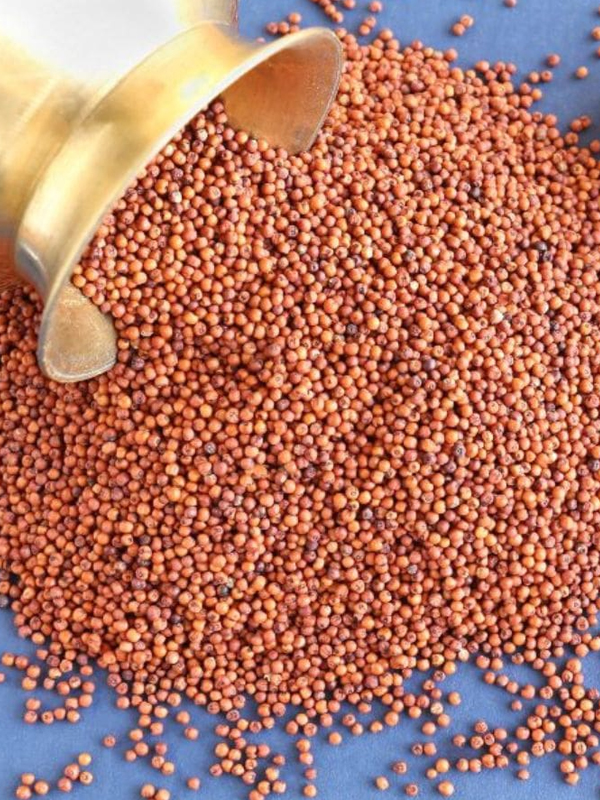Protein in 300 Gm of Chicken
Chicken - It has seen a significant rise in health consciousness, fitness trends, and protein-rich diets over the past decade.

Ragi, also known as finger millet, has been a staple in Indian households for centuries. It is one of the most nutritious grains, packed with essential nutrients, including protein, fiber, iron, calcium, and antioxidants.
Ragi, also known as finger millet, has been a staple in Indian households for centuries.
It is one of the most nutritious grains, packed with essential nutrients, including protein, fiber, iron, calcium, and antioxidants.
If you're looking to increase your protein intake naturally while maintaining a healthy diet, ragi is an excellent choice.
In this blog, we will explore ragi's protein content per 100g, its health benefits, how it compares to other grains, and ways to include it in your diet.
Whether you're a fitness enthusiast, a vegetarian looking for plant-based protein, or just someone aiming for better nutrition, this guide has something for you.
If you're looking for a plant-based protein source, ragi is an excellent choice. According to the Indian Council of Agricultural Research (ICAR).
Ragi contains approximately 7.3g of protein per 100g, making it a nutritious plant-based protein source, rich in fiber, calcium, and essential amino acids.
But protein isn’t the only nutrient ragi offers. Here’s a quick nutritional breakdown per 100g:
| Nutrient | Amount (per 100g) |
|---|---|
| Protein | 7-8g |
| Carbs | 72g |
| Fiber | 11g |
| Calcium | 344mg (34% DV) |
| Iron | 3.9mg (22% DV) |
Why does this matter?
Unlike refined grains, ragi provides complete amino acids, making it a near-complete protein source.
It’s gluten-free, making it ideal for those with gluten intolerance.
The high fiber content keeps you full longer, aiding digestion and weight management.
For vegetarians and vegans, ragi is a must-have in their diet to meet daily protein needs naturally.
How does ragi stack up against other popular grains in India? Let’s compare:
| Grain | Protein (per 100g) | Key Benefits |
|---|---|---|
| Ragi | 7-8g | High calcium, gluten-free |
| Quinoa | 14g | Complete protein, but expensive |
| Brown Rice | 7g | Easily digestible, low fiber |
| Wheat | 13g | High gluten, not suitable for all |
| Oats | 17g | High fiber, but may cause bloating |
Key Takeaways
While oats and quinoa have higher protein, ragi is more affordable and locally available in India.
Unlike wheat, ragi is gluten-free, making it a safer choice for many.
The calcium in ragi (344mg/100g) is 5x higher than milk, making it great for bone health.
For a budget-friendly, high-protein grain, ragi is a clear winner!
Athletes and fitness lovers often rely on whey protein, but plant-based options like ragi can be just as effective. Here’s why:
Ragi contains methionine, lysine, and tryptophan, crucial for muscle repair. While it’s not a complete protein like quinoa, combining it with dal or milk enhances its protein quality.
Due to its low glycemic index (GI), ragi provides sustained energy, preventing crashes during workouts.
Post-workout, muscles need protein and minerals. Ragi’s iron and calcium help in faster recovery compared to processed supplements.
Pro Tip: Try a ragi porridge with nuts after a workout for a protein-packed recovery meal!
To get the most protein from ragi, how you eat it matters. Here are the best ways:
Traditional South Indian ragi kali improves protein bioavailability.
Fermentation breaks down anti-nutrients, enhancing absorption.
Pairing ragi roti with sambar or dal creates a complete protein profile.
Sprouting increases protein content and digestibility.
Blend ragi flour with milk, bananas, and almonds for a protein-rich drink.
Avoid: Overcooking ragi, as it may reduce nutrient availability.
Many weight-loss diets fail due to hunger cravings. Rgi helps because:
✅ High Protein (7g/100g) – Keeps you full longer, reducing snacking.
✅ Rich in Fiber (11g/100g) – Slows digestion, preventing blood sugar spikes.
✅ Low Fat (1.3g/100g) – Ideal for calorie-controlled diets.
Study Alert: A 2020 study in the Journal of Nutrition found that millet-based diets reduced BMI more effectively than rice-based diets.
Best Weight-Loss Ragi Recipes
Ragi dosa (low oil)
Ragi malt with cinnamon
Ragi vegetable upma
Want to include more ragi in your diet? Try these easy, protein-rich recipes:
Mix ragi flour, mashed banana, eggs (or flaxseed for vegan), and milk.
Cook like regular pancakes topped with honey and nuts!
Blend soaked moong dal with ragi flour, ginger, and spices.
Make thin cheeks and serve with mint chutney.
Roast ragi flour, and mix with jaggery and crushed peanuts.
Shape into ladoos great for energy boosts!
Ragi is a nutritional powerhouse, offering 7.3g of protein per 100g, along with fiber, calcium, and essential nutrients.
Whether you are looking to build muscle, lose weight, manage diabetes, or simply eat healthier, ragi is an affordable, easily available, and highly nutritious grain for Indian diets.
By incorporating ragi-based recipes into your meals, you can enjoy both taste and health benefits. So why not start your journey with this ancient superfood today?
Chicken - It has seen a significant rise in health consciousness, fitness trends, and protein-rich diets over the past decade.
Almonds are one of the most popular nuts in India, known for their rich taste and impressive health benefits.
Cheese - When it comes to the rich and diverse world of dairy products in India, one name that immediately comes to mind is Amul.